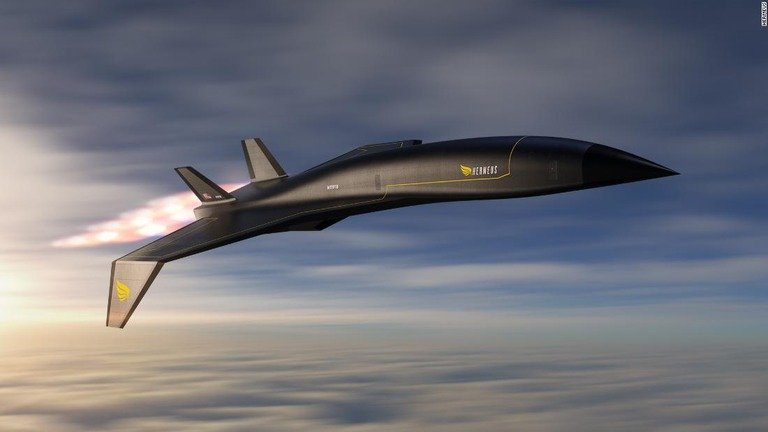Saturday, November 20, 2021

(CNN) Nearly 20 years have passed since the retirement of the supersonic airliner Concorde. At this point, interest in supersonic travel is increasing, and the development of multiple supersonic aircraft is progressing. Airlines are also interested, and United Airlines has already promised to offer supersonic routes in 2029.
But what about hypersonic trips above Mach 5 (five times the speed of sound)? From New York in the US to London in the UK, it takes about 3 hours on a Concorde and 6 to 7 hours on a regular airliner, whereas a hypersonic aircraft can travel in just 90 minutes.
Is it really possible?
Hermias, an Atlanta startup with the goal of developing hypersonic aircraft, believes it is possible. The company is already testing a new engine that will reach Mach 5 in the future. This engine was designed with the small unmanned hypersonic aircraft being developed by Hermias for the US Air Force in mind, but if scaled up, it can also be a power source for passenger aircraft.
The realization of such a passenger plane is still a long way off, and Hermias wants to carry out its first test flight in 2029. However, since the technology of the aircraft needs to be developed from scratch, Hermias has already made a detailed plan.
First of all, the aircraft will be significantly smaller than the current aircraft and the Concorde, which had a capacity of about 100 people.
"We first focused on business and first class passengers, then considered factors such as speed and operating costs, resulting in a 20-seater," said AJ Piprika, CEO of Hermias. We arrived at an aircraft equipped with a cabin. "
This is not much different from the capacity of a large business jet, so it seems that there will be only one class for the aircraft.
"I think we can make a profit with today's business class rates," Piprika said. However, it is unknown how many people will pay to fly five times faster, "the problem will not be answered until the product is out and the actual data is available."
Faster than ever
The cruising range of the aircraft is about 6400 km. This is sufficient for cross-Atlantic routes such as New York to Paris, but not enough for Pacific routes such as Los Angeles to Tokyo and requires connecting flights.
Land and air routes, such as from New York to Los Angeles, are not an option due to noise restrictions. If you break the sound barrier, you will hear a roaring sound, so you usually have no choice but to fly over the sea.
To understand how bold the Mach 5 airliner concept is, it is useful to look at past flight speed records.
The highest speed ever for an aircraft loaded with an engine is Mach 9.6. The NASA X43A, an unmanned aerial vehicle with a total length of about 3.6 meters, set a record in 2004.
Since the flight at this time lasted only a few seconds, the longest continuous flight record above Mach 5 is that of the Boeing X51. The aircraft was also an unmanned experimental aircraft and flew at Mach 5.1 for about 3 minutes in 2013. Both aircraft were launched by B52s from the sky and needed to be accelerated by rockets.
For manned vehicles, the current absolute speed record is Mach 6.7, established by the X15 in 1967. The aircraft was basically a rocket with seats developed for the purpose of achieving records, and also had to be launched from the sky by the B52.
For air-sucking aircraft that can take off and land on their own (aircraft powered by jet engines rather than rockets), the top speed record is "slightly" at Mach 3.3. This record was set in 1976 by the military reconnaissance aircraft SR71 "Blackbird".
There are only two types of supersonic passenger planes that have made commercial flights, and the maximum speed of one of them, Concorde, was Mach 2.04.
Therefore, if the proposed Hermias airliner is realized, it will greatly exceed the current fastest record for air-suction aircraft. A long flight at Mach 5 will surpass the record currently in the realm of unmanned experimental aircraft (of course, another aircraft could break the record before Hermias).
"Mature technology"
Given the above, it's not surprising that Hermias puts the initial focus on the engine. In February 2020, experiments aimed at designing a new engine began based on the existing model made by General Electric (GE) mounted on the fighter aircraft.
This engine is expected to be a hybrid of the two conventional technologies. It's a combination of a turbojet similar to that used by passenger planes and a ramjet that operates only above supersonic speeds. The engine will initially be installed in the hypersonic unmanned aircraft "Quarter Horse," which is under development through a $ 60 million partnership with the US Air Force.
Interestingly, when designing a jet engine for speed, parts are reduced rather than increased. In a turbojet, air enters from the front, is first compressed by a rotating blade, then mixed with fuel and ignited. The high-temperature gas generated by this is injected from the rear of the engine to propel the aircraft.
However, above Mach 3, it is not necessary to compress the air. The moment the air enters the engine, it is forced to slow down significantly, and it is automatically compressed. For this reason, at speeds from over Mach 3 to Mach 6, a type of engine called a ramjet is often used. The name literally comes from the engine colliding with the air ("ramming"). Unlike turbojets, it has no moving parts, but it does not operate at speeds below Mach 3.
Hermias plans to use its hybrid engine in turbojet mode during takeoff and landing and during subsonic flight. After that, as it reaches Mach 3 and accelerates to Mach 5, it gradually switches to ramjet mode.
"The turbojet part and the ramjet part are mature technologies that have been used independently for 50 years. The secret of this time is to combine the two. Around the ready-made turbojet engine We designed our own structure and proceeded with development based on it. "(Mr. Piprika)
Inspired by SpaceX
There are many issues that Hermias hasn't touched at this point. In addition to the question of what type of sustainable fuel to use (because it consumes significantly more fuel than current jets), the fuselage of hypersonic aircraft also needs to be able to withstand extremely high temperatures.
Concorde's speed was just temperature constrained, and at the end of the flight it was hot to the touch of the interior surfaces such as windows.
On the other hand, the SR71 "Blackbird" aircraft had to be made of rare metal titanium that can withstand extremely high temperatures, and the cockpit glass had to be made of quartz. During the mission, the surface temperature of the aircraft reached about 315 degrees.
While some are skeptical about the potential success of Hermias and the potential need for large amounts of funding, Piprika cites the example of SpaceX, led by CEO Elon Musk. Put out to.
"I think the same question was raised about the space industry in the early days of SpaceX." "It was said that it would cost $ 1 billion to put into orbit, but SpaceX used Falcon 1 to do it for $ 90 million. It was inserted "(Mr. Piprika)












0 コメント:
コメントを投稿